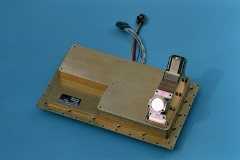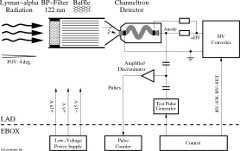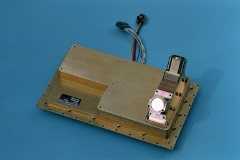LAD

The Lyman-Alpha Detector (LAD) experiments will provide knowledge of neutral hydrogen density in the geocorona extending into the magnetosphere. This set of actually two LAD instruments is a german science contribution from the Rheinische Friedrich-Wilhelms Universität, Bonn to the american TWINS mission. The Principal Investigator in Germany is Professor Dr. Hans-Jörg Fahr.
Company vH&S is the main contractor, and did all development, manufacturing, and qualification of the LAD instruments.
Two LAD Instruments in Space
The first of the two TWINS satellites, TWINS-1, with the LAD FM1 onboard, has been successfully launched into space from Vandenberg AFB, California at 28 June 2006. This launch was originally anticipated for December 2003, but it got delayed due to unknown reasons.
The second launch, TWINS-2, with the LAD FM2 onboard, was at 13 March 2008. As of 2015, both LAD instruments are still operational.
Functional Principle of the LAD Experiment
Each LAD instrument contains two Lyman-alpha sensors with a field of view of approx. 4 degrees. The two sensors are offset to each other by an angle of 80 degree. The LAD instrument is mounted on the TWINS payload, which itself is mounted on the TWINS spacecraft by a rotational platform. The oscillating movement of this platform allows the TWINS payload and the LAD instrument to scan large areas of the sky.
 The Lyman-alpha radiation enters the LAD experiment through optical bandpass filters centered at the Lyman-alpha wavelength (121.584 nm), and a pair of UV collimators. These are made from blackened aluminum honeycomb material, with thickness 25.4 mm, and a cell pitch of 1/16 in, giving the field-of-view (FOV) angle of approx. 4 degrees. The Lyman-alpha radiation is detected by channel electron multipliers (CEM), followed by detection amplifiers/discriminators. The statistical output pulse frequency of the discriminators is proportional to the Lyman-alpha intensity and is determined by digital pulse counters, which are located in the TWINS payload electronics box.
The LAD channeltrons require high voltage for operation. This is provided by a high voltage converter (HVC) within LAD. The HVC output voltage is enabled/disabled through a logic enable line. The exact HV value can be set through an analog control line from the TWINS electronics.
The Lyman-alpha radiation enters the LAD experiment through optical bandpass filters centered at the Lyman-alpha wavelength (121.584 nm), and a pair of UV collimators. These are made from blackened aluminum honeycomb material, with thickness 25.4 mm, and a cell pitch of 1/16 in, giving the field-of-view (FOV) angle of approx. 4 degrees. The Lyman-alpha radiation is detected by channel electron multipliers (CEM), followed by detection amplifiers/discriminators. The statistical output pulse frequency of the discriminators is proportional to the Lyman-alpha intensity and is determined by digital pulse counters, which are located in the TWINS payload electronics box.
The LAD channeltrons require high voltage for operation. This is provided by a high voltage converter (HVC) within LAD. The HVC output voltage is enabled/disabled through a logic enable line. The exact HV value can be set through an analog control line from the TWINS electronics.
The complete LAD instrument in full operation draws approx. 165 mW power. The instrument mass is just below 1 kg, with main mass contribution from the rather thick material of the aluminum housing, which will provide additional radiation shielding to the instrument electronics.
LAD Contact
To request more info, please write E-Mail to:
- Dr.-Ing. Hartmut Henkel, E-Mail: henkel @ vh-s.de
LAD Links
Here you find links of our partners:
- http://www.astro.uni-bonn.de/~hfahr Homepage of the Principal Investigator for the LAD experiments, Prof.-Dr. Hans-Jörg Fahr, Fachgruppe Physik-Astronomie, Rheinische Friedrich-Wilhelms Universität, Bonn, Germany.
- http://www.lanl.gov/~hfahr/prof_fahr2b.htm TWINS project page at Universität, Bonn.
- http://nis-www.lanl.gov/nis-projects/twins TWINS project page at the Los Alamos National Laboratory (LANL), Los Alamos, NM, USA.
Press Material
Here you find various material for immediate and unlimited publishing:
